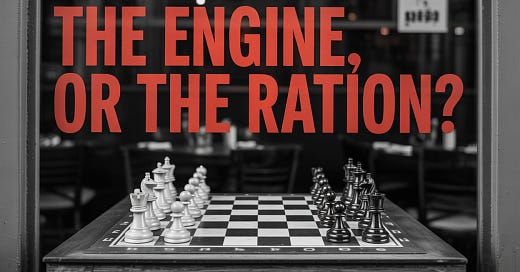There are very few moments in life when a single decision reveals an entire worldview.
How you choose to fund your retirement is one of them.
The choice is not, as the financial industry would have you believe, between a dizzying array of products.
It is a choice between two, and only two, fundamental philosophies of capital.
Today I want to talk about the annuity.
Not to attack it with the usual vitriol, but to dissect it.
Because the annuity is the purest physical manifestation of one of these capital philosophies, and by understanding it, we can fully grasp the power of the other.
One is the Path of the Ration. The other is the Path of the Engine.
The path you choose will determine everything.
An Annuity's Worldview
To understand the annuity, it helps to think of two archetypes.
The first is the hunter.
The hunter spends his life tracking a great beast—this is your career, your life of accumulating a nest egg.
One day, he succeeds.
He has his prize, a massive carcass.
His work is done.
Now, his singular focus shifts to preservation and rationing.
He knows the carcass is finite.
Every meal he takes diminishes the supply.
His primary source of "safety" is the accuracy of his rationing.
He must hope the meat lasts as long as he does.
This is the philosophical core of the annuity.
You trade your great beast—your lump sum of capital—to a large institution. In return, they agree to slice off a ration for you each month.
Your capital, in a practical sense, ceases to be yours.
It is no longer a living, dynamic asset. It has been rendered inert.
The worldview here is one of capital as a finite resource, and of your role as a passive recipient.
Let’s look at the mathematics of the ration.
A 65-year-old exchanges a $1,000,000 portfolio for an immediate annuity.
A competitive payout today might be around $65,000 per year. That is your ration. It is predictable. For the hunter, this predictability feels like safety.
But the world is not static.
Inflation and the silent erosion of purchasing power, are always at work.
Assuming a long-term average inflation of just 3.5%, here is the reality of the ration:
At age 65: Your $65,000 buys $65,000 worth of goods and services.
At age 75: Your $65,000 check now buys what approximately $46,000 would have a decade prior.
At age 85: Your $65,000 check has the purchasing power of just $32,600.
You are still getting your ration.
But the ration shrinks in its utility every single day.
The Path of the Ration is a path of guaranteed, managed decline.
The Path of the Engine
Now let’s consider the second archetype: the farmer.
The farmer also acquires assets.
But instead of a dead carcass, he acquires a herd of livestock—living, productive assets.
He does not plan his future by rationing his herd.
He plans it by breeding them.
His security comes not from the consumption of the principal, but from the productivity of it.
He lives on the milk, the eggs, the offspring.
His herd, his capital base, remains intact and, with skillful husbandry, grows over time.
This is the Path of the Engine.
It is the philosophy that underpins my entire approach, the Multiplier Loop. It defines capital not as a finite resource to be depleted, but as a productive engine to be operated, maintained, and upgraded.
Let’s apply the same $1,000,000 to this philosophy.
Instead of trading it for a ration, we use it to build an engine.
We construct a diversified portfolio of income-producing assets.
Using my four-pillar approach, a conservative, blended starting yield would be around 4%, generating $40,000 in first-year income.
The hunter, the annuity holder, scoffs. "$40,000? My ration is $65,000!"
And on day one, he is correct.
But the farmer understands time.
His engine is not static.
The companies in his portfolio grow their dividends.
The high-yield assets generate significant cash for reinvestment.
The engine has a growth rate.
Let’s be conservative and say the income it produces grows at 5% per year:
At age 65: Your engine produces $40,000. The annuity ration is higher.
At age 75: Your engine, with its income growing annually, now produces approximately $65,150 per year. It has now surpassed the annuity's nominal payout, and its purchasing power is vastly superior.
At age 85: Your engine is now producing over $106,000 per year. Meanwhile, your underlying $1,000,000 capital base has also grown, and remains entirely under your control.
The Path of the Ration provides more comfort at the start.
The Path of the Engine provides vastly more power over the long run.
Volatility vs. Fragility
Here we arrive at the central question.
The annuity salesman will claim his product is "safer."
This hinges entirely on a flawed definition of risk.
The financial establishment defines risk as volatility.
The day-to-day fluctuation of your portfolio's price.
An annuity brilliantly eliminates this.
Your statement is predictable.
It feels safe.
An operator, a farmer, has a different definition.
The real risk is not volatility; it is fragility.
Fragility is the inability of a system to adapt, grow, and withstand long-term pressures.
An annuity is the definition of a fragile system.
It has one source of income.
It has no ability to adapt to inflation.
It has no mechanism for growth.
It eliminates short-term volatility by maximizing long-term fragility.
The Multiplier Loop, the operator's engine, is designed to be the opposite: anti-fragile. It embraces a tolerable level of volatility as a necessary condition for growth and adaptation.
Its four pillars—Dividend Growth for stability, High-Yield for power, Buffett-Style Value for acquisition, and Options Income for control—are designed to create a redundant, adaptable system. It reduces fragility by design.
When you build an engine, you assert that your agency is your most valuable asset. The system is designed to amplify your control, not eliminate it.
A Choice of Worldview
I do not write this for a simple takedown of a financial product.
I write it because you must understand the philosophical contract you are signing.
The annuity is a rational choice for someone who genuinely believes they are a hunter at the end of a long hunt, and who wants nothing more than to hand off the carcass and receive a steady ration until the end.
There is a logic to it, I understand it, but it is the logic of managed decline.
My work, my philosophy, is for the farmer.
It is for the person who looks at their life's savings and sees not a relic to be protected, but an engine to be started.
The Multiplier Loop is the blueprint for that engine.
It is a commitment to the idea that the best way to secure your future is not to surrender your capital, but to command it.
So the choice is yours, and it is a profound one.
The Engine, or the Ration?









